The Evolution of Probability Density Function for Power System Excited by Fractional Gaussian Noise
Abstract
:1. Introduction
2. Modeling Description
2.1. The FBM and FGN
2.2. Malliavin Derivative and Stochastic Integration for FBM
2.3. An Itô Formula
2.4. Model of Power System Excited by FGN
3. The FPK Equation for SMIB Power System Excited by FGN
4. Numerical Solution of SMIB Power System Excited by FGN
5. Solution of the FPK Equation
5.1. Time-Dependent PDF
5.2. Stationary PDF
5.3. Impact of FGN on Stability
6. Conclusions
Author Contributions
Funding
Data Availability Statement
Acknowledgments
Conflicts of Interest
References
- Soong, T.T.; Grigoriu, M. Random vibration of mechanical and structural systems. NASA STI/Recon Tech. Rep. 1993, 93, 14690. [Google Scholar]
- Maymon, G. Structural Dynamics and Probabilistic Analysis for Engineers; Elsevier: Amsterdam, The Netherlands, 2008. [Google Scholar]
- Zhu, W.Q. Nonlinear stochastic dynamics and control in Hamiltonian formulation. Appl. Mech. Rev. 2006, 59, 230–248. [Google Scholar] [CrossRef]
- Mandelbrot, B.B.; Van Ness, J.W. Fractional Brownian motions, fractional noises and applications. SIAM Rev. 1968, 10, 422–437. [Google Scholar] [CrossRef]
- Duncan, T.E.; Hu, Y.; Pasik-Duncan, B. Stochastic calculus for fractional Brownian motion I. Theory. SIAM J. Control Optim. 2000, 38, 582–612. [Google Scholar] [CrossRef] [Green Version]
- Vas’kovskii, M.M. Analog of the Kolmogorov Equations for One-Dimensional Stochastic Differential Equations Controlled by Fractional Brownian Motion with Hurst Exponent H ∈ (0, 1). Differ. Equ. 2022, 58, 9–14. [Google Scholar] [CrossRef]
- Baudoin, F.; Coutin, L. Operators associated with a stochastic differential equation driven by fractional Brownian motions. Stoch. Process. Their Appl. 2007, 117, 550–574. [Google Scholar] [CrossRef] [Green Version]
- Vaskouski, M.; Kachan, I. Asymptotic expansions of solutions of stochastic differential equations driven by multivariate fractional Brownian motions having Hurst indices greater than 1/3. Stoch. Anal. Appl. 2018, 36, 909–931. [Google Scholar] [CrossRef]
- ML, K.; Le Breton, A.; Roubaud, M.C. General approach to filtering with fractional Brownian noises-application to linear systems. Stochastics Int. J. Probab. Stoch. Process. 2000, 71, 119–140. [Google Scholar]
- Xu, Y.; Pei, B.; Wu, J.L. Stochastic averaging principle for differential equations with non-Lipschitz coefficients driven by fractional Brownian motion. Stochastics Dyn. 2017, 17, 1750013. [Google Scholar] [CrossRef] [Green Version]
- Pei, B.; Xu, Y.; Wu, J.L. Stochastic averaging for stochastic differential equations driven by fractional Brownian motion and standard Brownian motion. Appl. Math. Lett. 2020, 100, 106006. [Google Scholar] [CrossRef]
- Pei, B.; Xu, Y.; Yin, G.; Zhang, X. Averaging principles for functional stochastic partial differential equations driven by a fractional Brownian motion modulated by two-time-scale Markovian switching processes. Nonlinear Anal. Hybrid Syst. 2018, 27, 107–124. [Google Scholar] [CrossRef]
- Deng, M.L.; Zhu, W.Q. Stochastic averaging of quasi-non-integrable Hamiltonian systems under fractional Gaussian noise excitation. Nonlinear Dyn. 2016, 83, 1015–1027. [Google Scholar] [CrossRef]
- Backus, D.K.; Zin, S.E. Long-memory inflation uncertainty: Evidence from the term structure of interest rate. J. Money Credit. Bank. 1993, 25, 701–708. [Google Scholar] [CrossRef]
- Rostek, S. Option Pricing in Fractional Brownian Markets; Springer: Berlin/Heidelberg, Germany, 2009. [Google Scholar]
- Granger, C.W.; Joyeux, R. An Introduction to long-memory time series models and fractional differencing. J. Time Ser. Anal. 2010, 1, 15–29. [Google Scholar] [CrossRef]
- Roche, S.; Bicout, D.; Maciá, E.; Kats, E. Long range correlations in DNA: Scaling properties and charge transfer efficiency. Phys. Rev. Lett. 2003, 91, 228101. [Google Scholar] [CrossRef] [Green Version]
- Mei, R.; Xu, Y.; Kurths, J. Transport and escape in a deformable channel driven by fractional Gaussian noise. Phys. Rev. E 2019, 100, 022114. [Google Scholar] [CrossRef]
- Wink, A.M.; Bernard, F.; Salvador, R.; Bullmore, E.; Suckling, J. Age and cholinergic effects on hemodynamics and functional coherence of human hipbpocampus. Neurobiol. Aging 2006, 27, 1395. [Google Scholar] [CrossRef]
- Chen, Y.C.; Dominguez-Garcia, A.D. A method to study the effect of renewable resource variability on power system dynamics. IEEE Trans. Power Syst. 2012, 27, 1978–1989. [Google Scholar] [CrossRef]
- Dhople, S.V.; Chen, Y.C.; DeVille, L.; Domínguez-García, A. Analysis of power system dynamics subject to stochastic power injections. IEEE Trans. Circuits Syst. Regul. Pap. 2013, 60, 3341–3353. [Google Scholar] [CrossRef]
- Gu, Y.; Xie, L. Stochastic look-ahead economic dispatch with variable generation resources. IEEE Trans. Power Syst. 2016, 32, 17–29. [Google Scholar] [CrossRef]
- Wu, H.; Krad, I.; Florita, A.; Hodge, B.M.; Ibanez, E.; Zhang, J.; Ela, E. Stochastic multi-timescale power system operations with variable wind generation. IEEE Trans. Power Syst. 2016, 32, 3325–3337. [Google Scholar] [CrossRef]
- Mohammed, H.; Nwankpa, C.O. Stochastic analysis and simulation of grid-connected wind energy conversion system. IEEE Trans. Energy Convers. 2000, 15, 85–90. [Google Scholar] [CrossRef]
- Wang, X.; Chiang, H.D.; Wang, J.; Liu, H.; Wang, T. Long-term stability analysis of power systems with wind power based on stochastic differential equations: Model development and foundations. IEEE Trans. Sustain. Energy 2015, 6, 1534–1542. [Google Scholar] [CrossRef] [Green Version]
- Apostolopoulou, D.; Dominguez-Garcia, A.D.; Sauer, P.W. An assessment of the impact of uncertainty on automatic generation control systems. IEEE Trans. Power Syst. 2015, 31, 2657–2665. [Google Scholar] [CrossRef] [Green Version]
- Wang, K.; Crow, M.L. The Fokker–Planck equation for power system stability probability density function evolution. IEEE Trans. Power Syst. 2013, 28, 2994–3001. [Google Scholar] [CrossRef]
- De Marco, C.; Bergen, A. A security measure for random load disturbances in nonlinear power system models. IEEE Trans. Circuits Syst. 1987, 34, 1546–1557. [Google Scholar] [CrossRef]
- Ju, P.; Li, H.; Pan, X.; Gan, C.; Liu, Y.; Liu, Y. Stochastic dynamic analysis for power systems under uncertain variability. IEEE Trans. Power Syst. 2017, 33, 3789–3799. [Google Scholar] [CrossRef]
- Lin, X.; Sun, L.; Ju, P.; Li, H. Stochastic control for intra-region probability maximization of multi-machine power systems based on the quasi-generalized Hamiltonian theory. Energies 2019, 13, 167. [Google Scholar] [CrossRef] [Green Version]
- Lin, S.J. Stochastic analysis of fractional Brownian motions. Stochastics Int. J. Probab. Stoch. Process. 1995, 55, 121–140. [Google Scholar] [CrossRef]
- Dai, W.; Heyde, C.C. Itô’s formula with respect to fractional Brownian motion and its application. Int. J. Stoch. Anal. 1996, 9, 439–448. [Google Scholar] [CrossRef] [Green Version]
- Biagini, F.; Hu, Y.; Øksendal, B.; Zhang, T. Stochastic Calculus for Fractional Brownian Motion and Applications; Springer Science and Business Media: Berlin/Heidelberg, Germany, 2008. [Google Scholar]
- LeVeque, R.J. Finite Difference Methods for Ordinary and Partial Differential Equations: Steady-State and Time-Dependent Problems; Society for Industrial and Applied Mathematics: Philadelphia, PA, USA, 2007. [Google Scholar]
- Kumar, P.; Narayanan, S. Solution of Fokker–Planck equation by finite element and finite difference methods for nonlinear systems. Sadhana 2006, 31, 445–461. [Google Scholar] [CrossRef]
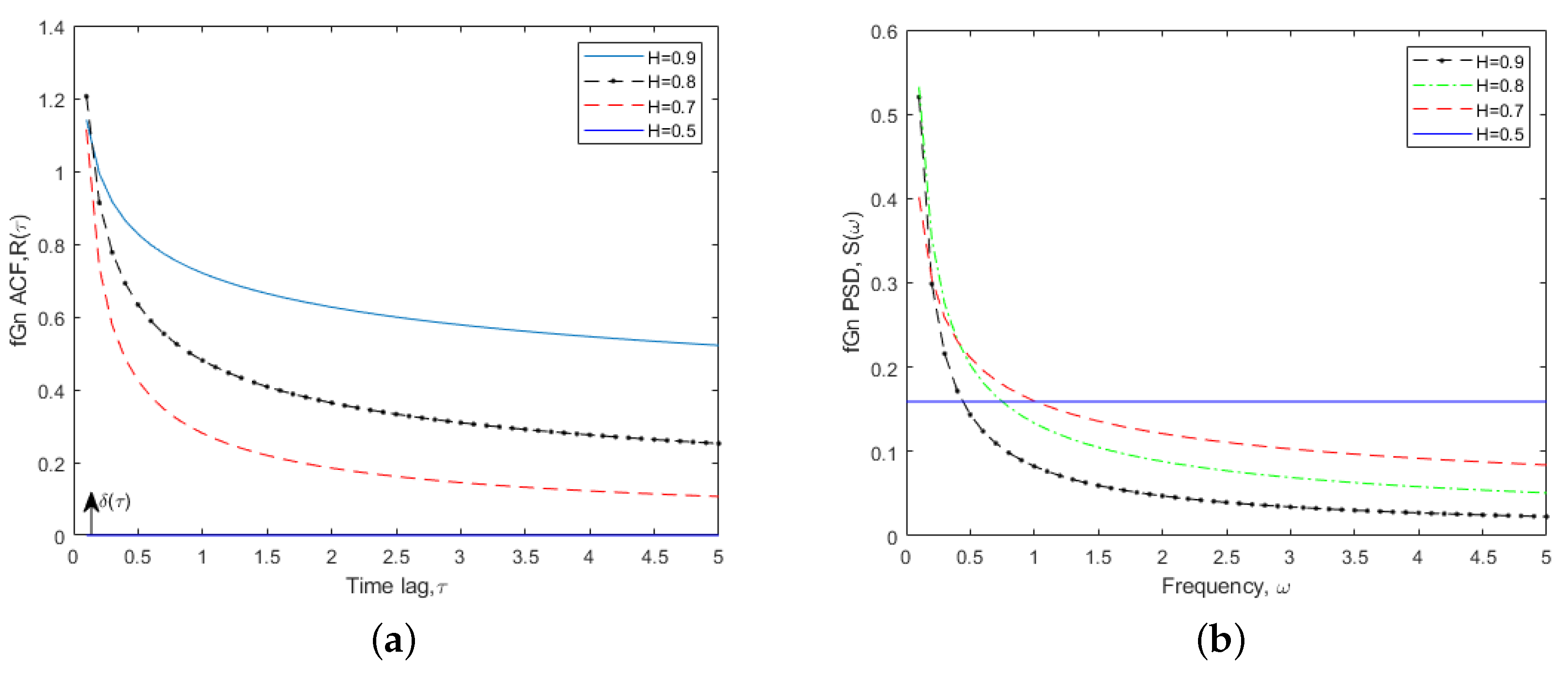


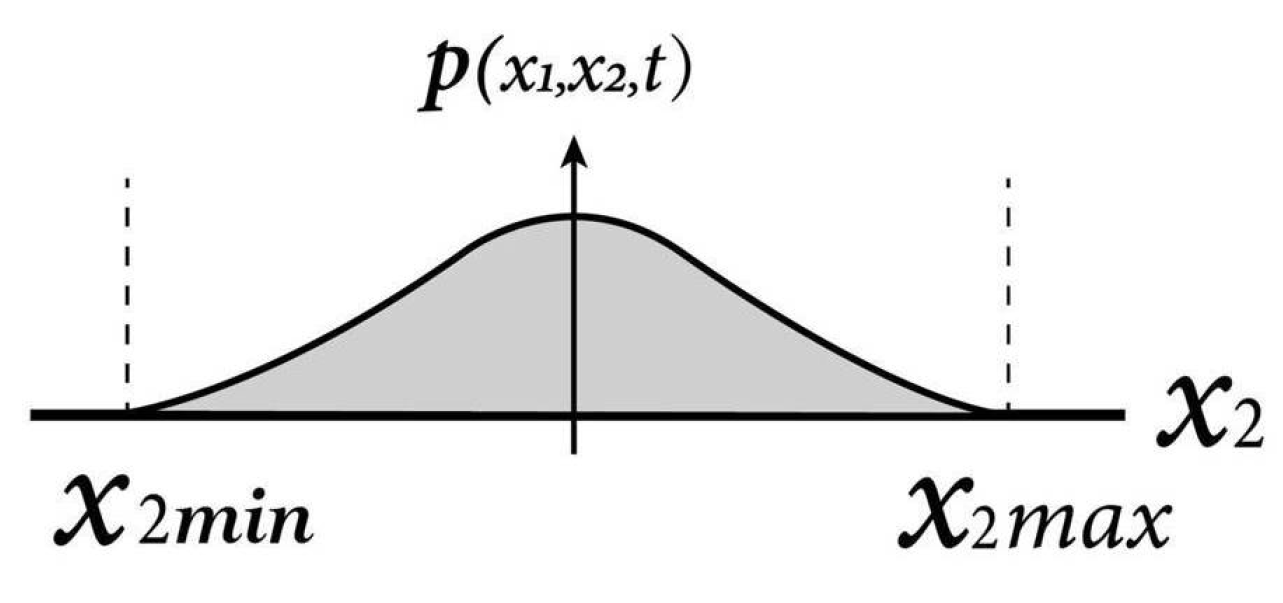
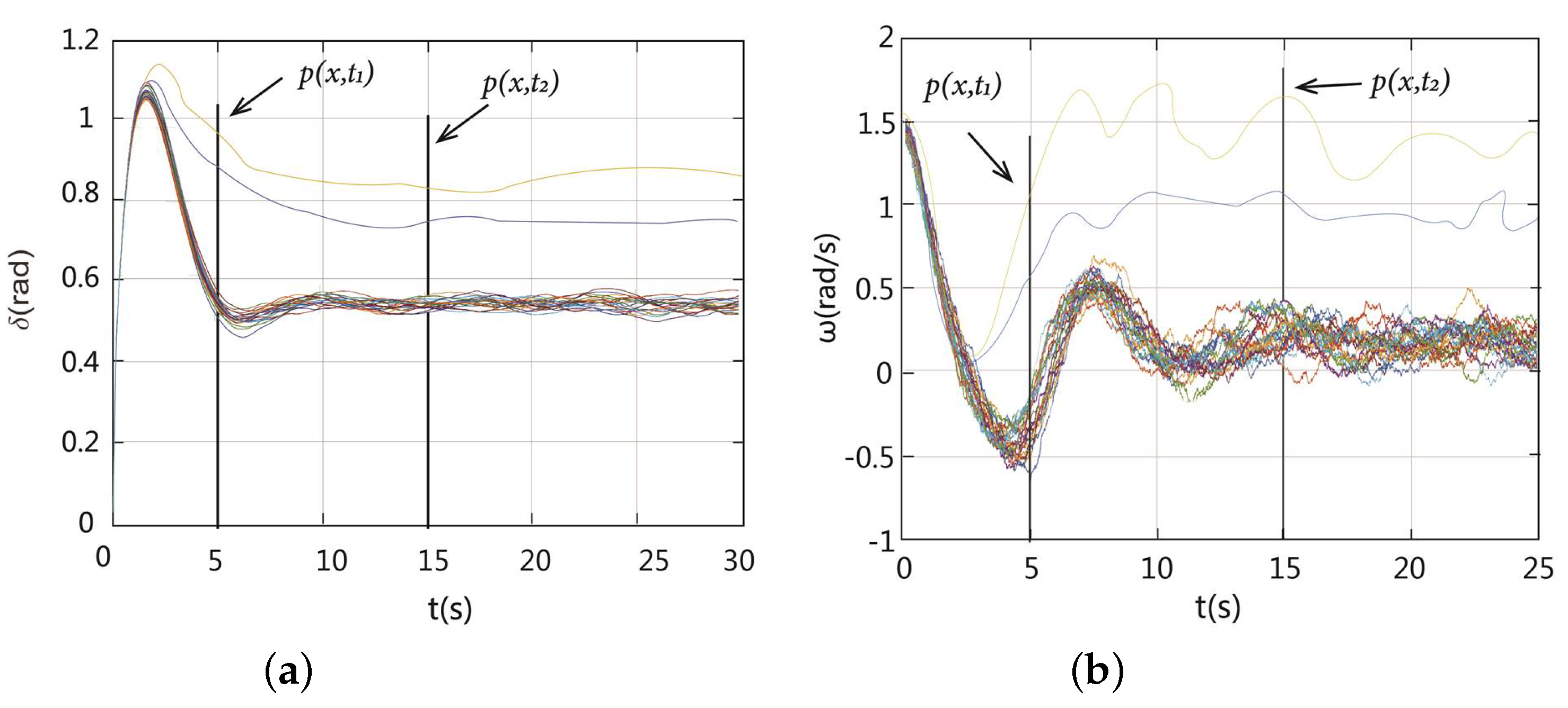
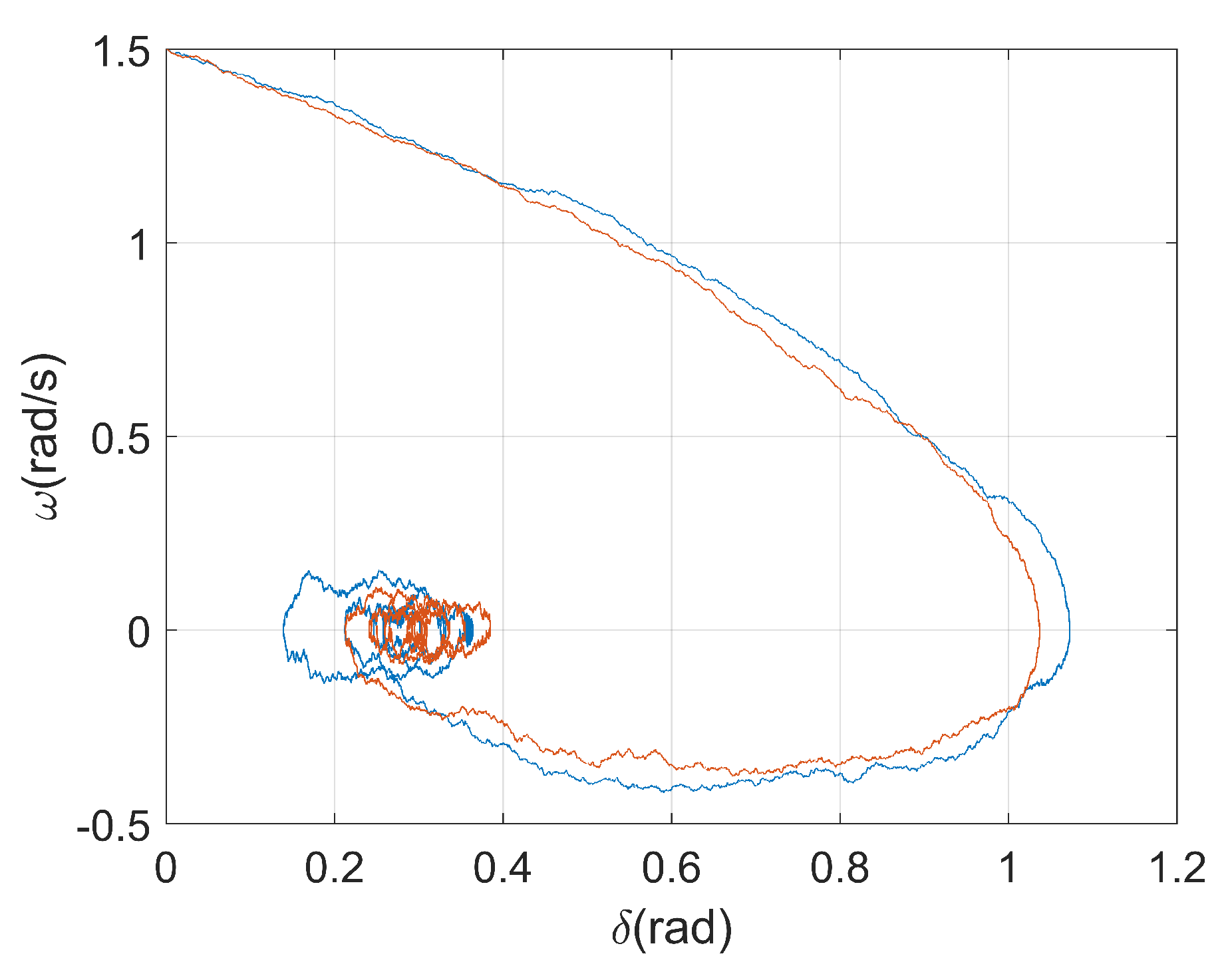


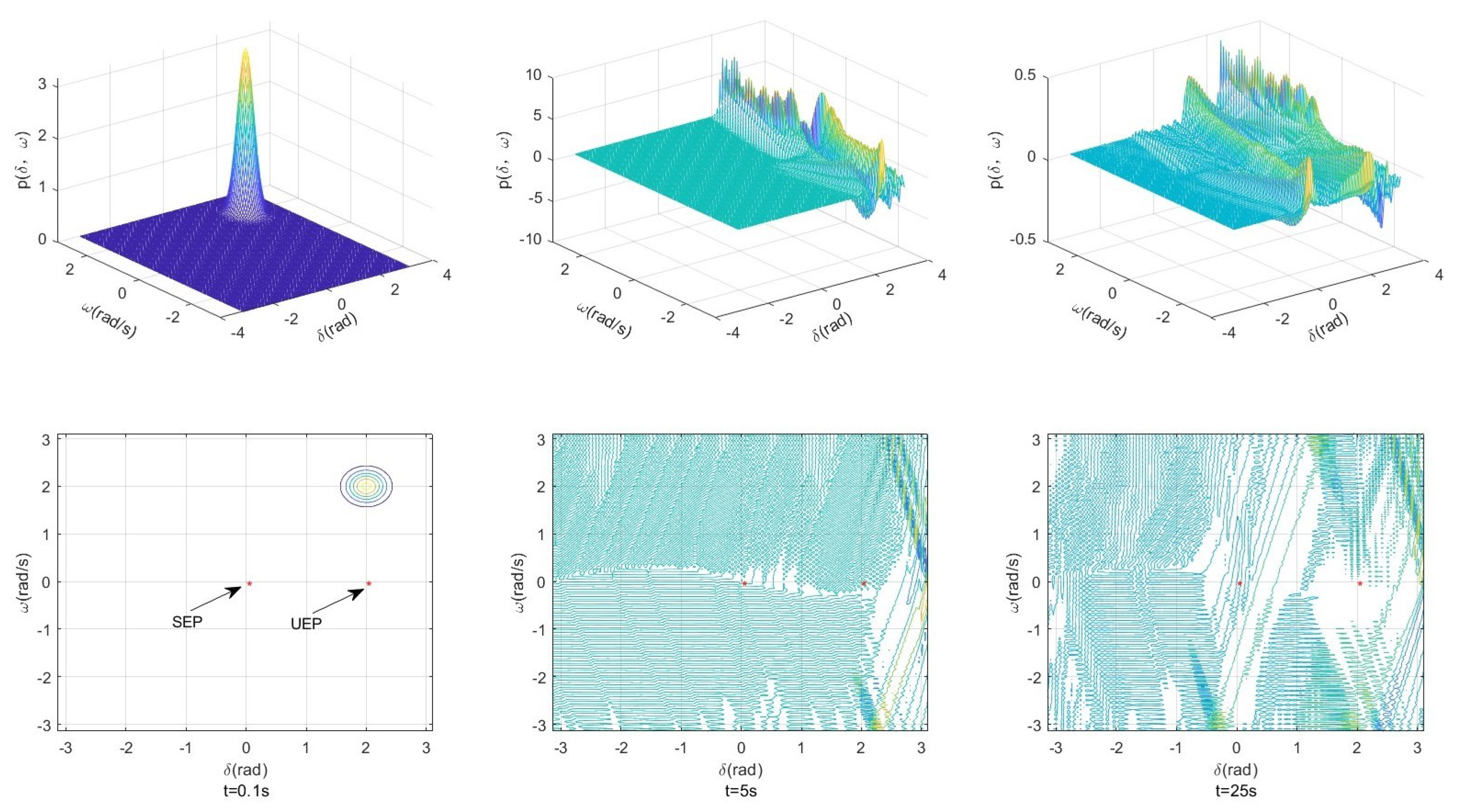

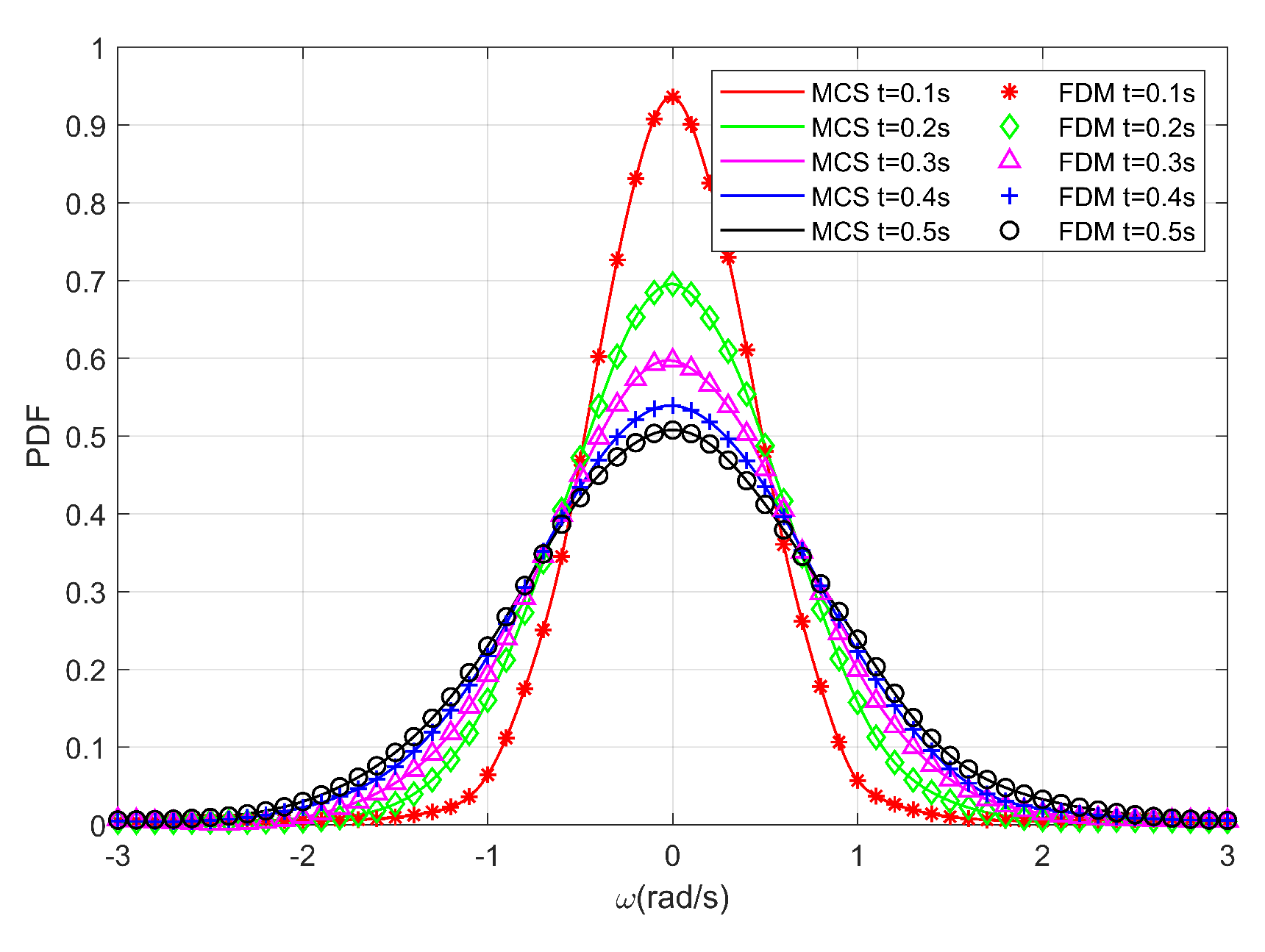


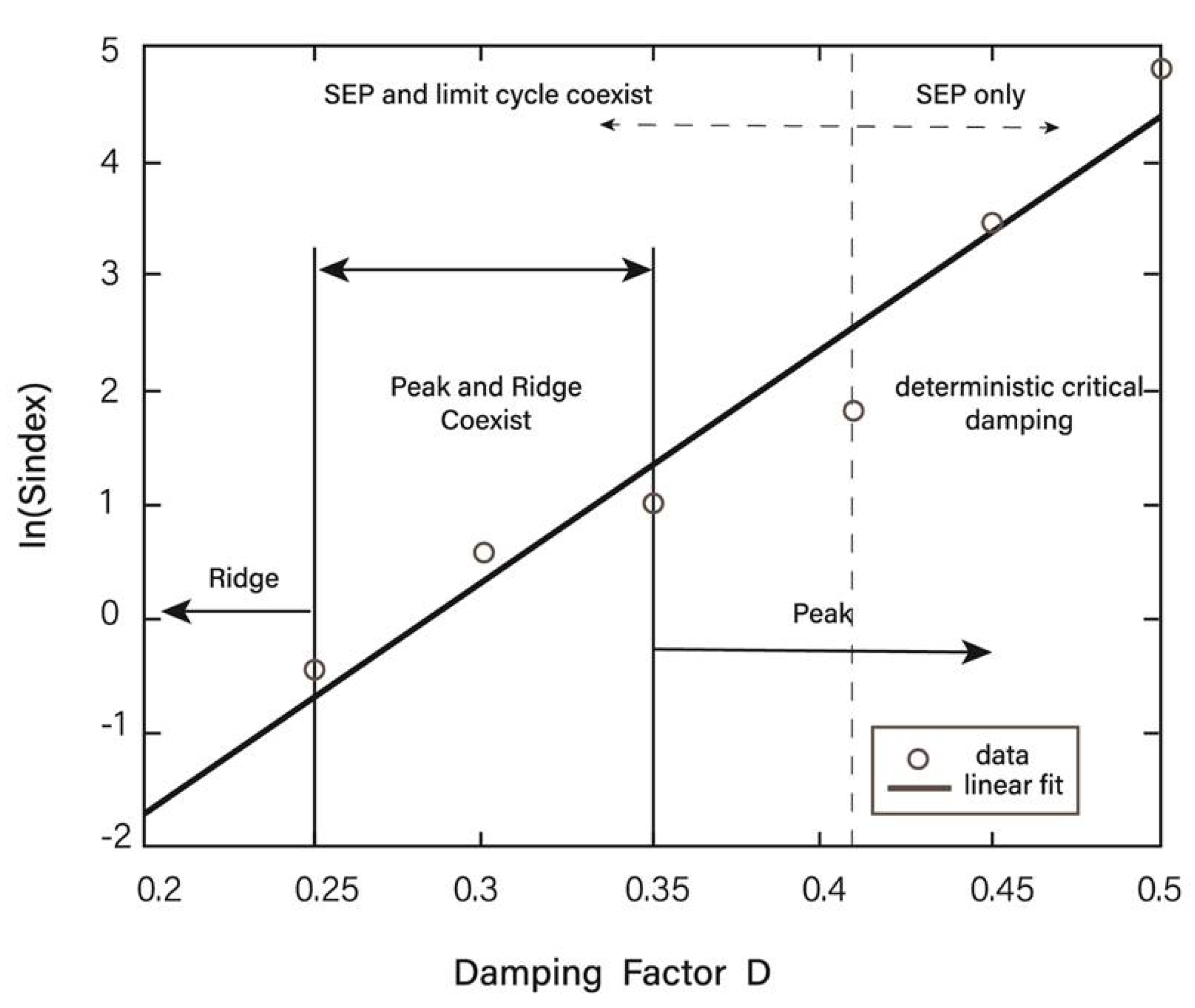
Disclaimer/Publisher’s Note: The statements, opinions and data contained in all publications are solely those of the individual author(s) and contributor(s) and not of MDPI and/or the editor(s). MDPI and/or the editor(s) disclaim responsibility for any injury to people or property resulting from any ideas, methods, instructions or products referred to in the content. |
© 2023 by the authors. Licensee MDPI, Basel, Switzerland. This article is an open access article distributed under the terms and conditions of the Creative Commons Attribution (CC BY) license (https://creativecommons.org/licenses/by/4.0/).
Share and Cite
Li, H.; Ma, S. The Evolution of Probability Density Function for Power System Excited by Fractional Gaussian Noise. Mathematics 2023, 11, 2854. https://doi.org/10.3390/math11132854
Li H, Ma S. The Evolution of Probability Density Function for Power System Excited by Fractional Gaussian Noise. Mathematics. 2023; 11(13):2854. https://doi.org/10.3390/math11132854
Chicago/Turabian StyleLi, Hufei, and Shaojuan Ma. 2023. "The Evolution of Probability Density Function for Power System Excited by Fractional Gaussian Noise" Mathematics 11, no. 13: 2854. https://doi.org/10.3390/math11132854
APA StyleLi, H., & Ma, S. (2023). The Evolution of Probability Density Function for Power System Excited by Fractional Gaussian Noise. Mathematics, 11(13), 2854. https://doi.org/10.3390/math11132854




